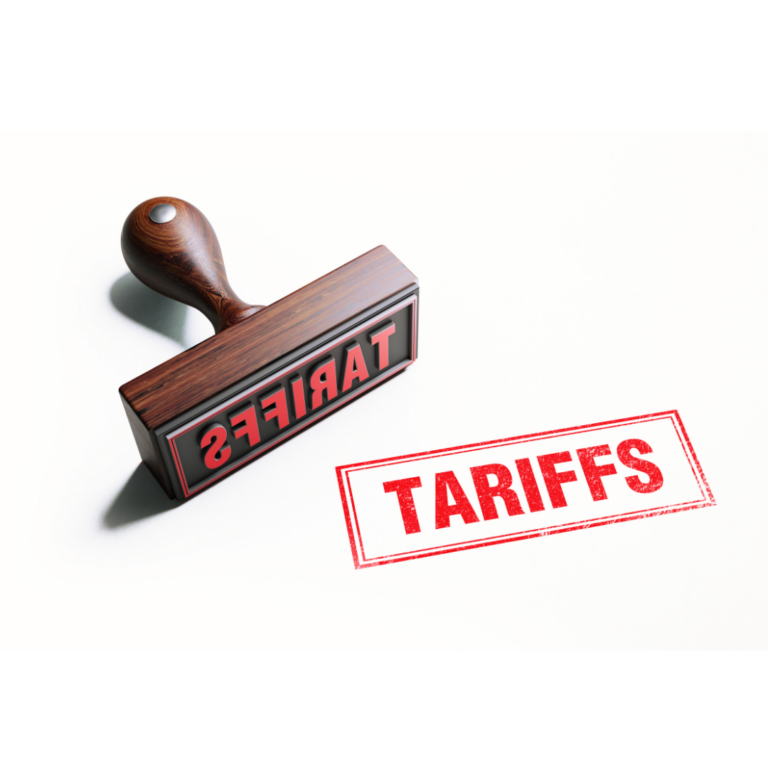By Breakwater Team
•
April 4, 2025
…grant me the serenity to accept the things I cannot change, the courage to change the things I can, and the wisdom to know the difference. – Reinhold Niebuhr In a year that had already witnessed a noticeable uptick in volatility compared to the prior two years, the ongoing back and forth regarding looming tariffs, culminated in what has been described by many pundits as some of the most aggressive levies introduced since the 1890s. While the policy announcements themselves have been well telegraphed, the scope and scale are considerably higher than what was expected, as evidenced by the market’s harsh response. Rather than imposing tariffs based on pre-existing trade protections with our counterparties (i.e., existing tariffs, subsidies, or other barriers to entry) the formula to arrive at the tariffs focused more on the trade imbalance between the two nations. As the largest economy in the world, trading with nearly everyone, many of which are much smaller countries/economies, this was ripe for distortion. For those who have been long time followers of President Trump’s beliefs this should come as little surprise, a recent piece in the WSJ captures quotes dating back to the 1980s which share his perspective that the US was drawing the short straw and other nations should have to pay to access our robust and dynamic economy. Going back to the days of the earliest trade when men roamed the earth hunting for food there has always been some degree of mercantilism whereby one group looks to accumulate power and wealth and protect their own interests, but in the Post World War II era, it’s inarguable that the US has benefited enormously from their embrace of “free trade” and capitalism. Our economy has grown a hundredfold since 1950 when it was approximately $270BB. The naysayers will point out that back then the US accounted for about 50% of global GDP, peak wealth, or about twice what it is today, but that fails to account for the fact that much of the world having fought the theatres of war in both Europe and the Pacific was in ruin and needing to be rebuilt. There is a misconception that both NAFTA (1994) and China’s entry into the World Trade Organization (2001) were the watershed moments leading to the hollowing out of the US’s manufacturing base, but in reality manufacturing employment had been in decline going back to 1950. At its peak US manufacturing workers accounted for about 30-35% of the nonfarm workforce, whereas today that level sits at around 8% where it has hovered for the last 15 years. In 2000 it was just 15% so still very much the minority. This long-term shift in the mix of the US economy where services now account for a disproportionate percentage of GDP and the workforce overall is the result of a far more skilled workforce driving both innovation and productivity. Surely some manufacturing jobs have left based on the focus on corporate profits, but some of the change relates to comparative advantage and inexpensive labor. It’s not to say, that we should look to push all manufacturing to the most “efficient” destination, surely it’s important to maintain control of manufacturing of critical components to defense, information technology or medicine, but it seems unrealistic at best to expect that we can produce enough and at reasonable costs to satisfy our insatiable demand. We are after all only about 5% of the world’s population, though we account for 25% of global GDP. Talk about punching above our weight. Aside from the logistical challenges that reshoring/onshoring pose, not to mention the timeline associated with the payback for such efforts, the willingness or lack thereof on the part of the business and consumers alike beg the question of whether or not it is worth pursuing. Considering our societal tendencies for policy to reverse course every 4-8 years with Washington’s constant changing of the guard which has grown even more partisan in recent years, it’s hard to envision the private sector making these investments where there may be little or no long-term benefit to the majority of stakeholders, mainly consumers and shareholders alike. If we are being intellectually honest, as we have seen with the likes of Amazon, if automation or robotics can do the work better than human beings, who need benefits and breaks, the case for this policy bolstering manufacturing employment seems weak at best. That’s one of the key pillars of the artificial bull case after all. In addition, there is clear evidence that economies which produce a disproportionate amount of goods versus services are much more susceptible to the boom bust cycle as demand for goods themselves is far more cyclical, look no further than Japan and Germany whose export driven economies have largely languished for the last 20 years in the slow growth/no growth period in the aftermath of the Great Financial Crisis. Let’s put all this into context, according to the World Trade Organization as of 2023 the US had a trade weighted tariff rate of 2.2% lower than nearly all countries around the world. For a country that is such a massive importer one might argue the low levels fostered healthy trade relations with some of our key allies and admittedly some frenemies or altogether poor bedfellows. With these sweeping tariffs, some as high as 49%, this marked a significant shift in policy where the aforementioned tariff rates will approach 30%, having a significant and lasting impact on consumers and businesses alike. Whether you want to describe a tariff as something different than a tax seems to be semantics, the added expense is rarely fully eaten by the producer. In the aftermath of the pandemic and the correspondingly high inflation due to excessive fiscal and monetary policy along with supply side disruptions, its doesn’t require too much detective work to know the average American is exhausted or outraged by higher prices. The tariffs will only add to the price at the register unless we all of a sudden find the private sector extraordinarily benevolent, willing for much if not all of the added costs to result in shrinking margins. By now you have surely figured out why there was such a market kerfuffle, but let’s make sure to fully examine why the result was to shave $3 trillion of market value off of US stocks in one day, which supposedly is the equivalent of 5 years’ worth of tariff receipts. First and foremost, despite opening the year with an economy bumping along with real GDP around 2.50% we have seen a sharp decline in the soft data, where surveys from the confidence board and University of Michigan plumb levels we have not seen going back to the pandemic when fears of a severe respiratory infection and 10% unemployment were front of mind. The hard data has been only a little better as labor has held up thus far, but as we have seen in Retails Sales there are signs that the consumer may be tapped out or growing wearier. With GDP likely to be between negative .5% to positive .50% for Q’1 that it’s like slamming on the brakes while driving in the passing lane. No surprise that there may be a real sense of whiplash. As the odds of a recession have risen, something the President himself acknowledges, it’s safe to assume expectations for earnings growth this year and next seem to be slipping away. With valuations stretched, there has been little margin for error and it’s those stocks, some of the most expensive that have felt the impact that much more acutely. This is why we have heard the “Mag 7” referred to as the “Lag 7” here in early 2025. Now you might be thinking this is likely transitory, a word that is making its rounds again after an ill-feted debut to Wall Street vernacular in 2022. If we are in fact, we are likely to see a shift to a more capital-intensive economy, is it reasonable to justify such high multiples which made more sense in an asset light, intangible heavy ecosystem? It seems hard to justify, from this vantage point. Hopefully, we will avert a recession, but that’s not to say it is an all-clear sign for the stock market. Earnings recessions, like that of 2022, may not lead to large scale job losses and disinflation, but increase the prospects for a bear market. There is a risk here that those fat margins whither because of trade frictions and lead to something more pernicious like a repeat of the stagflation episode of the 1970s and early 1980s where higher inflation sucks the oxygen out of the room leaving little room for real growth. So, what is an investor to do… Well for one thing, maintaining discipline in the form of diversification has helped and likely will continue to, with investors who have roughly half of their portfolio in overseas stocks and fixed income, the positive returns in these two areas have been able to offset some of the decline in US stocks. Incorporating other assets like Treasury Inflation Protected Securities (TIPs), gold or real estate may help mitigate the risk somewhat but as we have seen in the past times of market angst correlations often increase, giving the appearance there is no place to hide. Eventually markets will calm down, as the last of the sellers capitulate, though that process can take weeks or even months to play out. I’ll leave you with some quotes from some of the smartest minds on Wall Street to ponder as we head into the weekend. “Sometimes the share price of a firm tells the CEO of that firm nothing about their company they didn’t already know. Other times, the stock market takes on the role of “active informant.” Stock prices predict investment because they provide business managers with useful information about the future. I think now is probably one of those times. -Neil Dutta, Head of Economics, Renaissance Macro “We all know the math: the stock market has historically grown by 10-11% over the long run but only gone up 60-70% of the time. That means it has corrected 30-40% of the time. Surviving those drawdowns is the price of admission.” -Jurrien Timmer, Director of Global Macro at Fidelity Investments “We are a great nation, the leader of the free world. Yet we squander our political power to appease the textile industry in the Carolinas! We should instead be setting a standard or the world by practicing freedom of competition, of trade, and of enterprise that we preach. -Milton Freidman This presentation is not an offer or a solicitation to buy or sell securities. The information contained in this presentation has been compiled from third-party sources and is believed to be reliable; however, its accuracy is not guaranteed and should not be relied upon in any way whatsoever. This presentation may not be construed as investment, tax or legal advice and does not give investment recommendations. Any opinion included in this report constitutes our judgment as of the date of this report and is subject to change without notice. Additional information, including management fees and expenses, is provided on our Form ADV Part 2 available upon request or at the SEC’s Investment Adviser Public Disclosure website, www.adviserinfo.sec.gov. Past performance is not a guarantee of future results.













